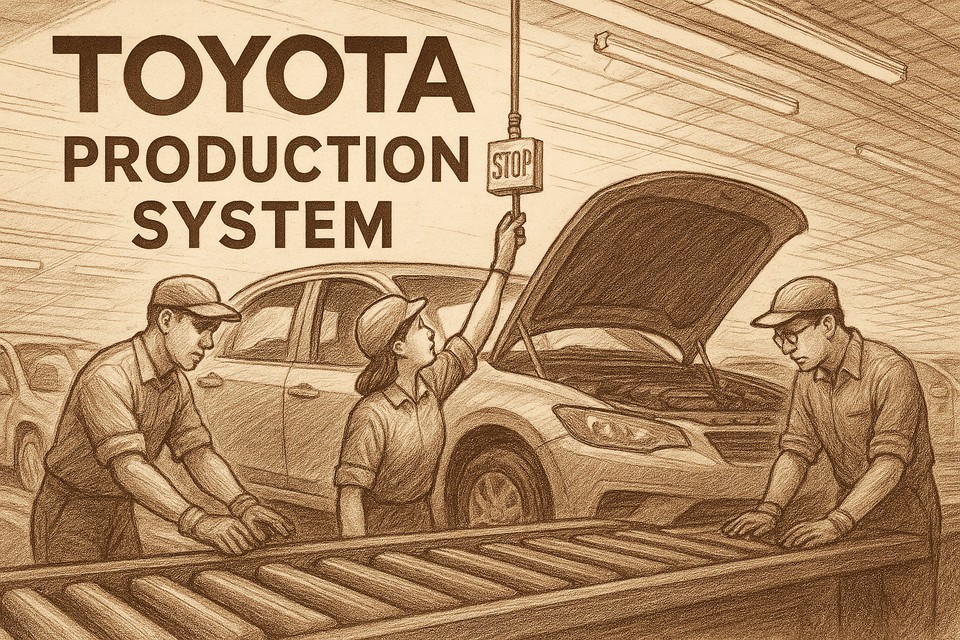The Toyota Way : Delivering Through Discipline

In the world of manufacturing, few names resonate like Toyota. Not because it builds the flashiest machines, but because it builds the most reliable ones. Because it changed how the world thinks about quality, scale, and learning.
At Toyota, performance comes from process. Innovation comes from observation. Reliability comes from discipline.
Origins: Efficiency Born from Constraint
Toyota was founded in 1937 by Kiichiro Toyoda as a spin-off from his father's textile machinery company. Its early years were marked by economic hardship, scarcity of resources, and the aftershocks of war. These constraints became the crucible in which its engineering culture was forged.
Rather than imitate American-style mass production, Toyota developed a distinct model that fit its environment: small batches, minimal inventory, and high worker involvement. Inspired by supermarket stocking patterns and honed through careful experimentation, this evolved into what we now know as the Toyota Production System (TPS). It focused on lean production, minimising waste and maximising learning. Every process was built to expose flaws early, involve workers deeply, and iterate constantly. The result was not merely operational efficiency. It was a culture of shared responsibility.
What Technical Leaders Can Learn
Stabilise output to reduce stress and waste. Toyota practised Heijunka to level demand and eliminate bottlenecks. In IT, this mirrors managing sprint scope, controlling WIP (work in progress), and avoiding late-stage crunches.
Automate, but do not abdicate. Toyota’s principle of Jidoka ensured systems could stop automatically when problems arose, preserving quality and protecting learning. In IT, observability and alerting should halt unsafe deploys, not merely report them after the fact.
Toyota's system design assumes that people bring intelligence, judgement, and creativity to their work. Workers are not merely task executors. They are observers, problem-solvers, and contributors. Every element of the Toyota Production System was designed to support autonomy with alignment. In environments where complexity and change are constant, recognising the cognitive capacity of those closest to the work is not only respectful. It is essential.
Toyota’s approach fits modern software delivery precisely because software is uncertain. Just as manufacturing had to adapt to variable inputs and unpredictable demand, IT must adapt to changing requirements, environments, and expectations.
Small batches, incremental validation, and the ability for anyone to intervene, these practices reduce risk in fast-moving, complex ecosystems. At Toyota, speed was never purchased at the expense of quality. Rules, process, and standardisation existed to protect delivery, not to hinder it.
- Build systems that reveal problems early. The Andon cord allowed any worker to stop the line when something went wrong. In IT, build feedback loops into your CI/CD pipelines, logging, and testing workflows.
- Treat the system, not just the symptom. Toyota focused on root causes. They asked "why" five times. IT teams must investigate failure as a chance to improve, not merely restore.
- Empower those closest to the work. The best ideas at Toyota came from workers on the floor. In IT, engineers, not only managers, must be invited to shape process, quality, and outcomes.
- Standardise to improve, not to constrain. Standardisation at Toyota reduced friction, improved quality, and made improvement measurable. In IT, shared tooling and patterns accelerate change when applied purposefully.
- Build in quality; do not inspect for it. Quality was designed into every step. In software, code quality, security, and observability must be part of the build, not a late-stage gate.
- Improve constantly, learn collectively. Kaizen means continuous improvement. Improvement is not a special initiative, rather a habit shared by the team. High-functioning teams inspect, adapt, and refine every cycle, not because they are told to, but because the system makes learning obvious and action possible. These are not techniques to be copied blindly. They are principles to be practised deliberately, embedded into culture, and refined through doing.
Proven by Endurance: Reliability Under Pressure
Toyota's commitment to discipline and refinement shaped more than just factories. It extended to racetracks. The company has made its mark in endurance motorsport, most notably at the 24 Hours of Le Mans and in the FIA World Endurance Championship (WEC).
In 2019, Toyota set a new lap record at Le Mans, and in the 2024 WEC Prologue in Qatar, its GR010 Hybrids covered a combined 3,093 kilometres across 571 laps, the greatest distance of any Hypercar team during the event. These achievements were not merely about speed. They demonstrated what Toyota stands for: systems that work, even under pressure, over time.
Endurance, like reliability in IT, is not built through bursts of performance. It is built through consistent engineering choices that compound over time.
Culture in Motion: People Build the Product
Discipline and adherence to foundational principles were non-negotiable at Toyota. Every improvement began with respect for the system and a shared understanding of how it should behave. Rules were not viewed as constraints. People approached them as a language of clarity. Obedience to process was not about compliance but about trust in collective reasoning and logical consistency.
Every aspect of TPS, from lean principles to the Andon cord, trusted workers not only to execute tasks, but to improve the work itself. A worker could pull a cord to stop the entire line, not to assign blame, but to highlight a problem needing attention. Every stoppage became a moment for learning and root cause resolution.
Rotations ensured breadth of understanding. Standardised tasks created shared ownership. Continuous improvement, Kaizen, was a lived practice, not a slogan.
Toyota believed in people. It scaled excellence by trusting those closest to the work. Whether through training, rotations, or listening to the front line, Toyota built its system around human insight. Cars only reflected it as the result.
In IT, sustainable delivery does not come from tools or architecture alone. It comes from people who care, are trusted, and are able to act.
Toyota’s Influence on IT: From Factory Floor to Codebase
Align before you act. Toyota practised Nemawashi, a discipline of pre-alignment before execution. In IT, preparing together before a major change saves far more than it delays. Consensus is not bureaucracy. It build velocity earned through clarity. The connection between Toyota's practices and modern IT is more than metaphor. It is foundational.
Toyota’s ideas did not remain confined to factories. Over time, its principles, lean thinking, continuous improvement, root cause analysis, reshaped how the world builds systems. The influence of TPS can be found in Agile methodologies, DevOps culture, and the rise of cross-functional teams in software engineering.
IT did not invent iteration, retrospectives, or small-batch delivery. Toyota proved them first, at scale, under real world constraints, away from a virtual lala land. Every deployment pipeline, every kanban board, and every blameless post mortem carries its DNA.
Toyota taught us that process is not the enemy of creativity, but its platform.
Final Takeaway: Go Slow to Go Far
Toyota did not dominate by sprinting. It did not succeed by cutting corners. It succeeded by respecting the system, trusting its people, and learning every day.
Excellence is built into the process—or it is not built at all.
Speed comes and goes. Stability scales. Design your delivery like it must still be working ten years from now … and make your team proud to own it.





Member discussion